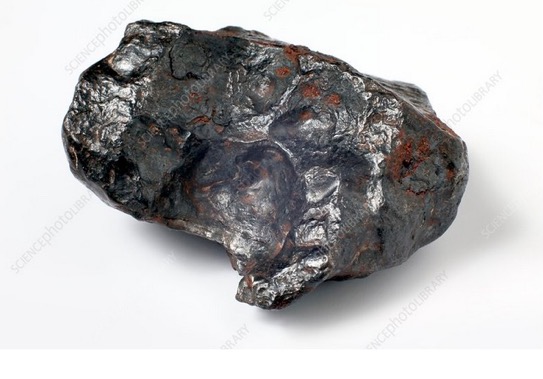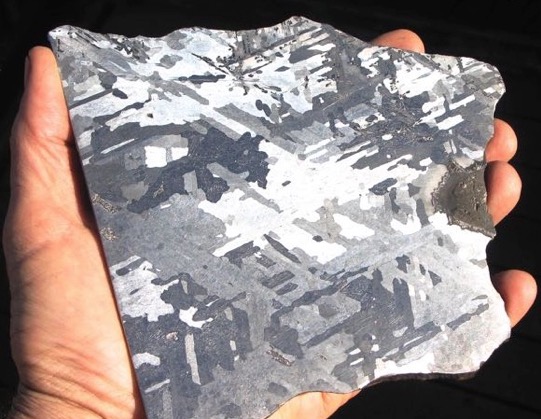Meteorites are stuff from outer space; each is a solid piece of debris which formed from dust within the protoplanetary disc or from object such as an asteroid, planetesimal, or planet, and which travels through space and falls through the atmosphere to the surface of earth. As alien objects which fall dramatically they have evoked interest and wonder among many people. I remember vividly at the age of ten watching with my dad the meteorites fall during a Perseid Meteor Shower such as shown in time lapse photography in Figure 1. We both were greatly excited by the sights of the darting meteor trails and the awe felt by both of us felt was almost palpable. This fond memory has prompted me to write about meteorites in hopes of further acquainting my readers with them.
I will write three blogs about meteorites; in the first I’ll consider both iron and stony-iron meteorites, and the following blogs will be about chondrites and achondrites, both classes of stony meteorites, and lastly about chondrules, which are constituents of chondrites and are sub-millimeter to millimeter-sized spherules containing silicates and another minerals and are often quite beautiful.
The three major classifications of meteorites based on their mineral compositions are: stony meteorites which are comprised of silicate minerals, iron meteorites which primarily are comprised of an alloy of iron and nickel, and stony-iron meteorites which are comprised of a mixture of iron-nickel alloy and silicate minerals. Iron-nickel meteorites can also contain sulfide, carbide, phosphide minerals of iron, nickel, cobalt, and chromium, as well as native carbon. The class of stony-iron meteorites are comprised of two subclasses, pallasites and mesosiderites[. The distribution of classes of meteorites found world-wide are shown in TABLE 1 and examples of them are Figures 2-5.

TABLE 1. DISTRIBUTION OF CLASSES OF METEORITES BY FALLS FOUND THROUGHOUT THE WORLD
| METEORITE CLASSIFICATION | PERCENTAGE |
| Stony | 97.4 |
| Iron-Nickel | 2.0 |
| Pallasite | 0.2 |
| Mesosiderite | 0.4 |
IRON AND STONY-IRON METEORITES
Meteorites containing an iron-nickel alloy are classified as the iron meteorites, and the stony iron meteorites, the latter including the pallasites and the mesosiderites.
In the iron meteorites the iron-nickel alloy is present as two minerals: kamacite which contains up to 7.5% dissolved nickel in solution with iron and taenite with more than 25% nickel in solution. Other minerals which contain iron, nickel, cobalt, phosphorous, oxygen, sulfur, and carbon in lesser abundance may be present in iron meteorites. These minerals with their compositions are summarized in Table 2. Each minda.org reference contains representative photographs of the mineral.
TABLE 2. MAJOR MINERALS FOUND IN IRON AND STONY IRON METEORITES
| MINERAL | CHEMICAL FORMULA | MINDAT.ORG REFERENCE |
| Kamacite | (Fe,Ni) | 8 |
| Taenite | (Fe,Ni) | 9 |
| Troilite | FeS | 10 |
| Daubre’elite | Fe2+Cr3+2S4 | 11 |
| Cohenite | (Fe,Ni,Co)23C6 | 12 |
| Schreibersite | (Fe,Ni)3P | 13 |
| Chromite | Fe2+Cr3+O4 | 14 |
| Magnetite | Fe3O4 | 15 |
| Corundum | Al2O3 | 16 |
| Graphite | C | 17 |
| Diamond | C | 18 |
| Lonsdaleite | C | 19 |


The Structure and Metallurgy of Iron-Nickel Meteorites
Iron-nickel meteorites are thought to be remnants of the cores of planetesimals following collision between them . With slow cooling during solidificaiton of the core the liquid alloy mixture of iron and nickel results in a mixture of the two minerals kamacite and taenite. With sufficiently slow cooling to 912 deg C and below discrete visible crystals of each mineral form separately as shown in the iron-nickel phase diagram. The interleafed arrangement of the crystals results in the arrangement called Widmanstatten Figures as shown in Figure 3 which become visible upon etching with an acid. The different grey-tones of the crystals develop from different etching susceptibilities which arise from the different atomic arrangements within face-centered cubic kamacite and body-centered cubic taenite.
Structure, Mineral Composition, and Formation of Stony-iron Meteorites
Stony-iron meteorites consist of approximately equal parts of iron-nickel alloy and silicate minerals as opposed to stony meteorites which primarily are made up of silicate minerals. Stony-iron meteorites are divided into two groups, the pallasites and the mesosiderites Pallasites have silicate minerals, mostly olivine embedded in the meteoric iron. Mesosiderites are breccias comprised of fragments of meteoric iron interspersed with fragments of silicate minerals.
Pallasites
Results of a recent study suggest that pallasite meteorites may have formed in a glancing impact between a body with a largely solidified core surrounded by a molten layer and a larger body. It is assumed that loss of the solid core and formation a body comprised of aggregates of fragments of olivine surrounded by molten iron-nickel alloy ensued. Solidification of the molten alloy results in cementation of the olivine fragments which results in the structure shown in Figure 4

Mesosiderites
Mesosiderites are considered to have formed from fragments of iron-nickel alloy and silicate minerals which resulted from collision of metal-rich and silica-rich asteroids. The fragments may be of the igneous rocks, basalts, gabbros, and pyroxenites of igneous rocks as well as fragments of the minerals orthopyroxene, olivine, and plagioclase. The Iron-nickel metal is mostly in the form of millimenter or sub-millimeter grains admixed with grains of silicate minerals in the same size range surrounding the larger fragments of rocks and minerals. These structural features are shown in Figure 5.




